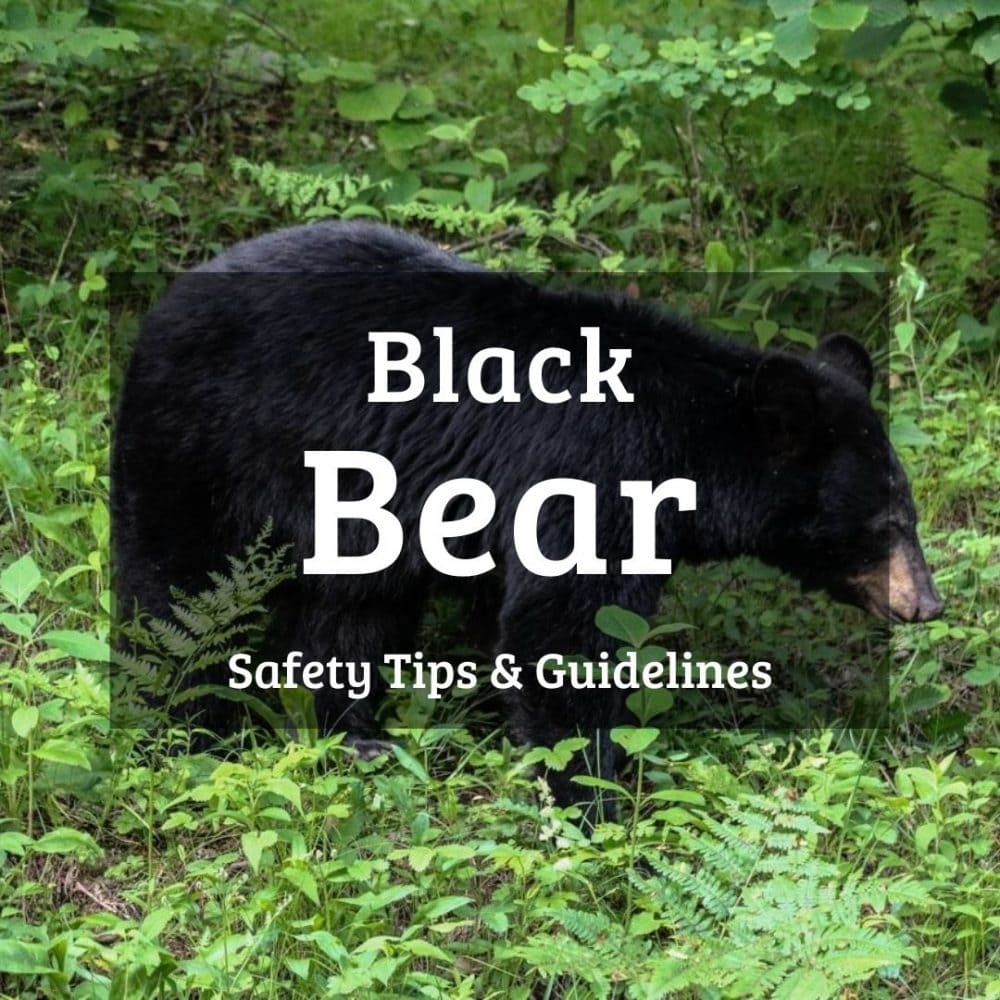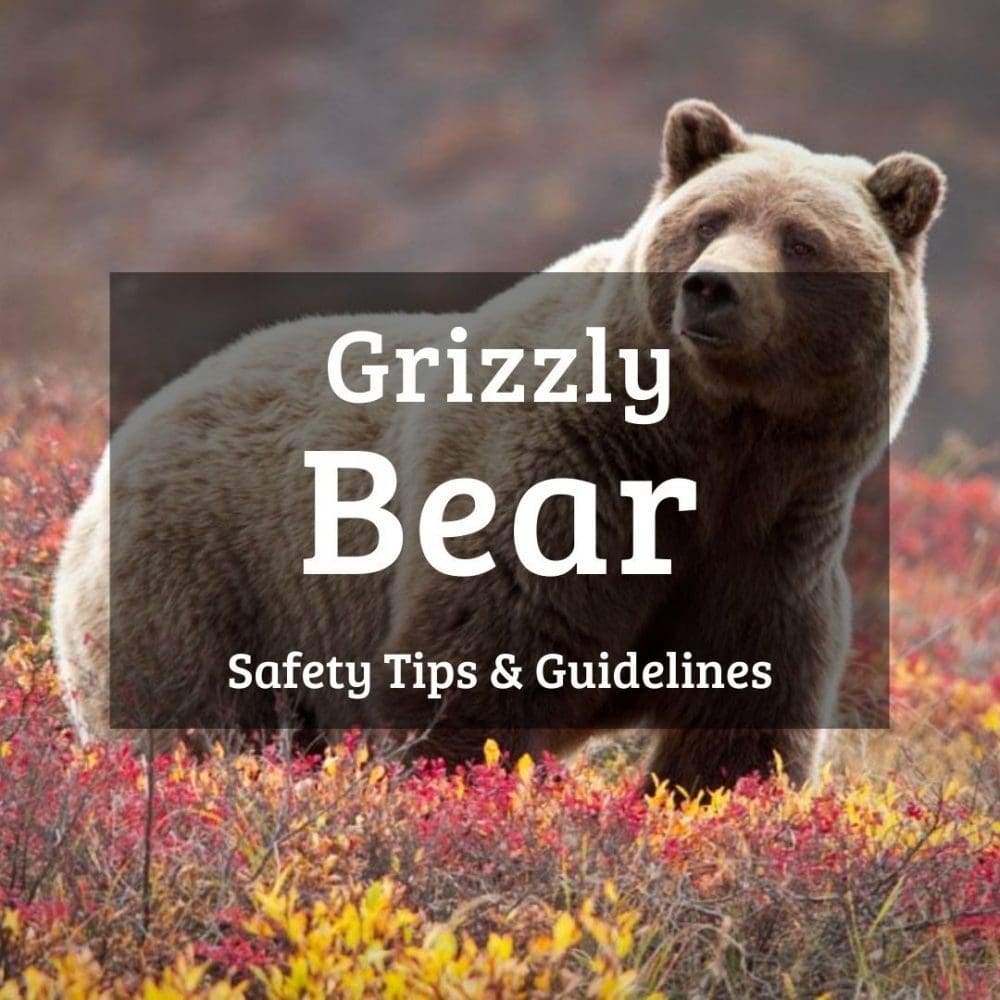One of the great pleasures of visiting Yellowstone National Park is seeing bears in the wild. Both black bears and grizzly bears call the park home and are active—and therefore visible—for a large part of the year.
However, the bears in Yellowstone do hibernate in winter. After starting this months-long sleep sometime in November, they’re not seen again until spring the following year.
Below, you’ll find a wealth of information about bear hibernation in Yellowstone National Park, including black bear hibernation and grizzly bear hibernation habits.
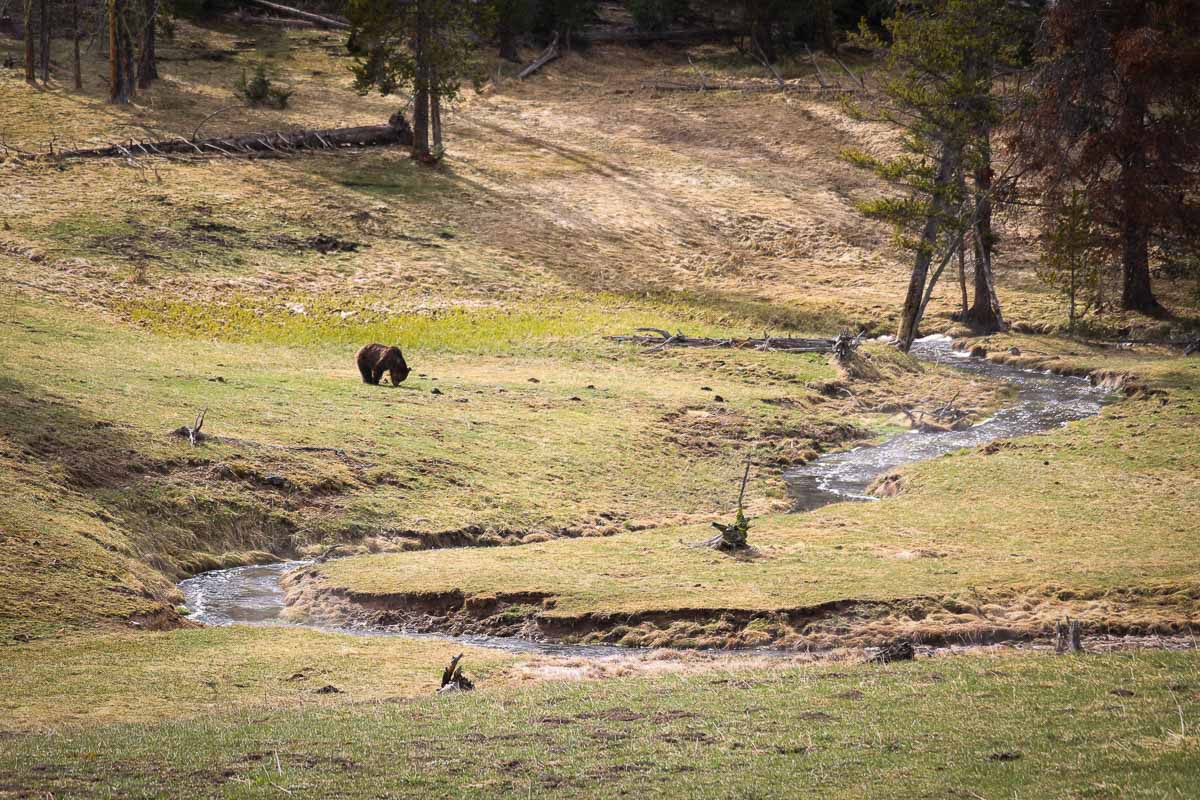
This blog post about bear hibernation in Yellowstone National Park contains affiliate links. You can read more about our Terms of Use / Disclosure here.
Contents
- What Is Hibernation? Why Do Bears Hibernate in Yellowstone?
- Black Bear Hibernation in Yellowstone National Park
- Where Do Black Bears Hibernate in Yellowstone National Park?
- When Do Black Bears Start Hibernation in Yellowstone National Park?
- When Do Black Bears Emerge From Hibernation in Yellowstone National Park?
- How Long Do Black Bears Hibernate in Yellowstone National Park?
- What Do Black Bears Eat After Hibernation?
- Grizzly Bear Hibernation in Yellowstone National Park
- Where Do Grizzly Bears Hibernate in Yellowstone National Park?
- When Do Grizzly Bears Start Hibernation in Yellowstone National Park?
- When Do Grizzly Bears Emerge From Hibernation in Yellowstone National Park?
- How Long Do Grizzly Bears Hibernate in Yellowstone National Park?
- What Do Grizzly Bears Eat After Hibernation?
- How to Distinguish Between Black Bears and Grizzly Bears
- Bear Safety in Yellowstone
- Recommended Books About Yellowstone National Park
What Is Hibernation? Why Do Bears Hibernate in Yellowstone?
Hibernation is how some mammals deal with seasonal food shortages, snow cover, and low winter temperatures.
From small animals like chipmunks and ground squirrels to massive grizzly bears, hibernation is how they conserve energy during the year’s harshest period.
Especially in Yellowstone National Park, food is extremely scarce in winter, while the weather can be downright terrible. Hibernating is, therefore, the bears’ most logical option.
Although bears weren’t considered “true hibernators” for quite a long time, they’re now regarded by scientists as “super-hibernators.”
Thanks to their thick layers of fat and fur, they’re able to keep their body temperature above 88°F during hibernation (which is only about 12°F below their normal body temperature).
Because of this, bears can respond more quickly to potential danger than other hibernators, such as the aforementioned chipmunks and ground squirrels, who have to warm up before they can move swiftly.
Additionally, because of their large size and insulating pelts, bears tend to lose body heat less quickly than smaller mammals, allowing them to reduce their metabolic rate by up to 50-60%.
Bears breathe approximately 1 time every 45 seconds while hibernating (down from their normal 6-10 breaths per minute). Their heart rate also drops to 8-19 beats per minute (down from their regular 40-50 beats per minute).
Altogether, their reduced metabolism, slow breathing, and low heart rate make them “super-hibernators.”
This essentially means that they do not have to wake up occasionally to move around, urinate, defecate, drink, and even eat—which mammals with a higher hibernating metabolism do have to do during winter.
Simply put, bears in Yellowstone sleep throughout the winter season, stirring only very sporadically and very rarely getting up.
As similar as hibernation patterns are between the bears of Yellowstone National Park, there are some notable differences between black bears and grizzly bears. Let’s take a closer look at those below.
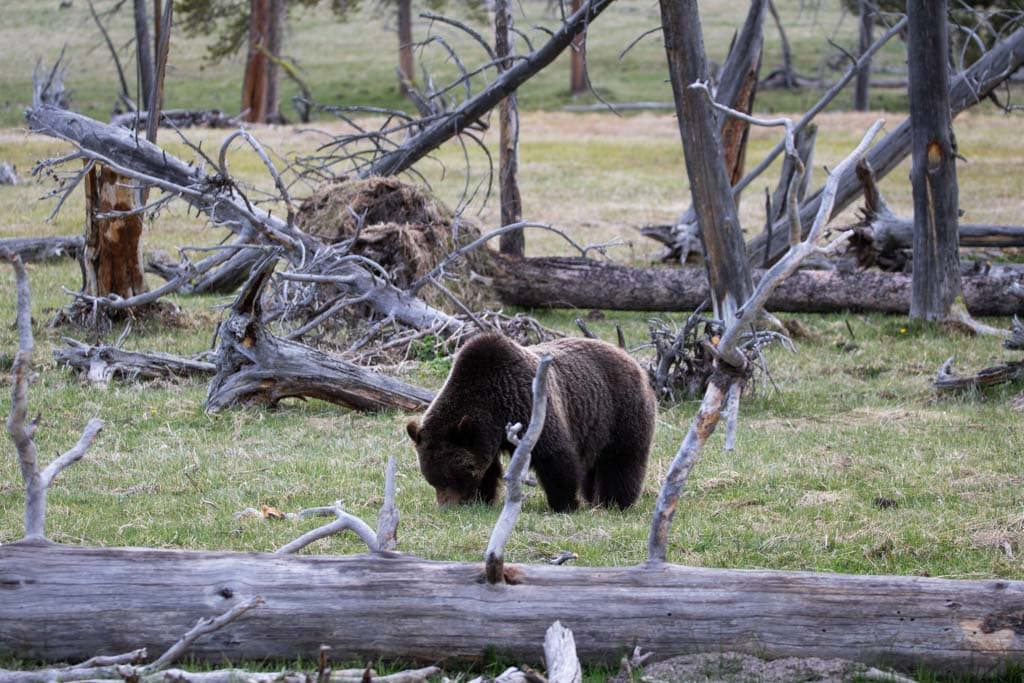
Black Bear Hibernation in Yellowstone National Park
Where Do Black Bears Hibernate in Yellowstone National Park?
In Yellowstone National Park, black bears hibernate in dens located on north-facing 20°-40° slopes. Their dens are typically at an altitude between 5,800 and 8,600 feet.
A black bear may either locate a den or excavate one itself. Common black bear den locations include caves, hollow trees, under piles of wood or dead trees, self-dug dens, and previously occupied dens.
When Do Black Bears Start Hibernation in Yellowstone National Park?
The start of hibernation for black bears depends on the seasonal weather. Usually, however, they begin moving into their dens sometime in the second half of November.
Typically, black bears (as well as grizzlies) tend to hang around their den for a week or two before actually starting their hibernation. They’re very lethargic during that time, taking frequent naps, but not entering full hibernation yet.
Particularly severe weather might push them into their dens as early as late-October, though, while warmer conditions might keep them up until early-December.
Their final incentive to enter their dens for winter is typically provided by a snowstorm. A popular theory says that the fresh snow covers their tracks and hides the location of their den.
Pregnant females are the first ones to enter their dens. They’re followed by females with young cubs. The last to start their hibernation are adult male bears.
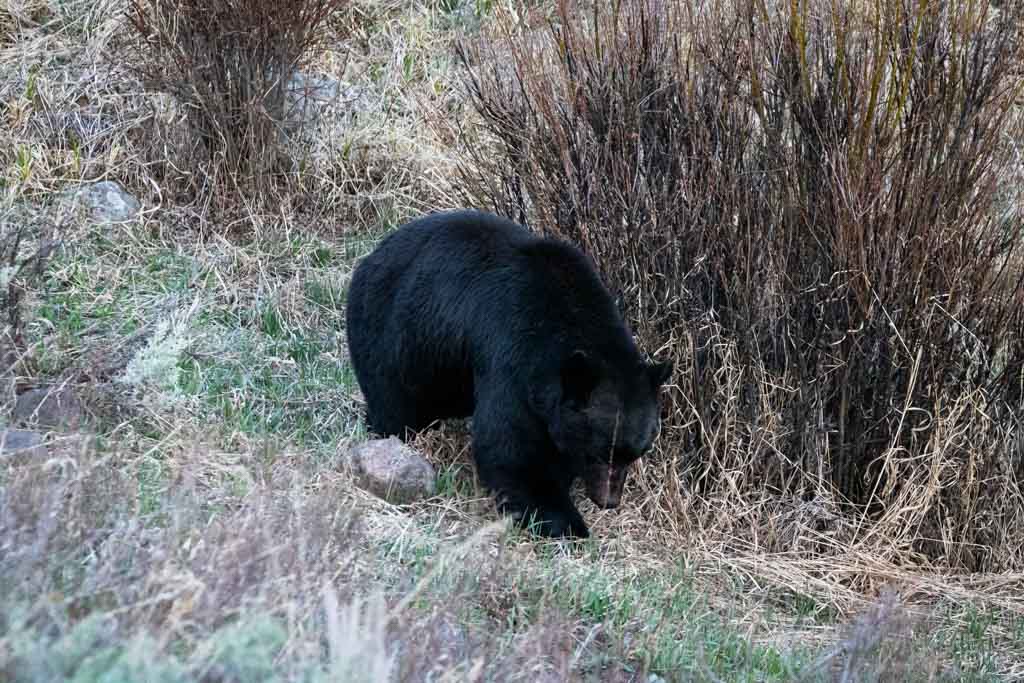
When Do Black Bears Emerge From Hibernation in Yellowstone National Park?
Black bears are usually the first bears to emerge from hibernation in Yellowstone. This is due to the location of their dens, which are at a lower altitude than grizzlies’ and are, therefore, a bit warmer.
They start emerging sometime in March. The first to emerge are adult male black bears, who may leave their dens as early as late-February.
Then, solitary females and females with yearlings or two-year-old cubs emerge. The last to exit their dens are females with newborn cubs, which can be as late as mid-April.
- Male black bears: late-February to early-March
- Solitary female black bears: March
- Females with yearlings or two-year-old cubs: late-March
- Females with newborn cubs: late-March to mid-April
How Long Do Black Bears Hibernate in Yellowstone National Park?
Black bears hibernate for about 4-5 months in Yellowstone. This is, however, highly dependent on seasonal weather in winter, as well as on whether it’s a solitary female, female with cubs, or male bear.
What Do Black Bears Eat After Hibernation?
After hibernation, black bears are understandably extremely hungry. They will eat anything edible they come across.
Winter-killed animals, such as deer, elk, and bison, are a preferred food source, but competition from the larger and more aggressive grizzly bears might shift their focus to other food.
Black bears also eat grasses, leaves, roots, insects, rodents, and trout. Later in spring, they may also hunt elk calves.
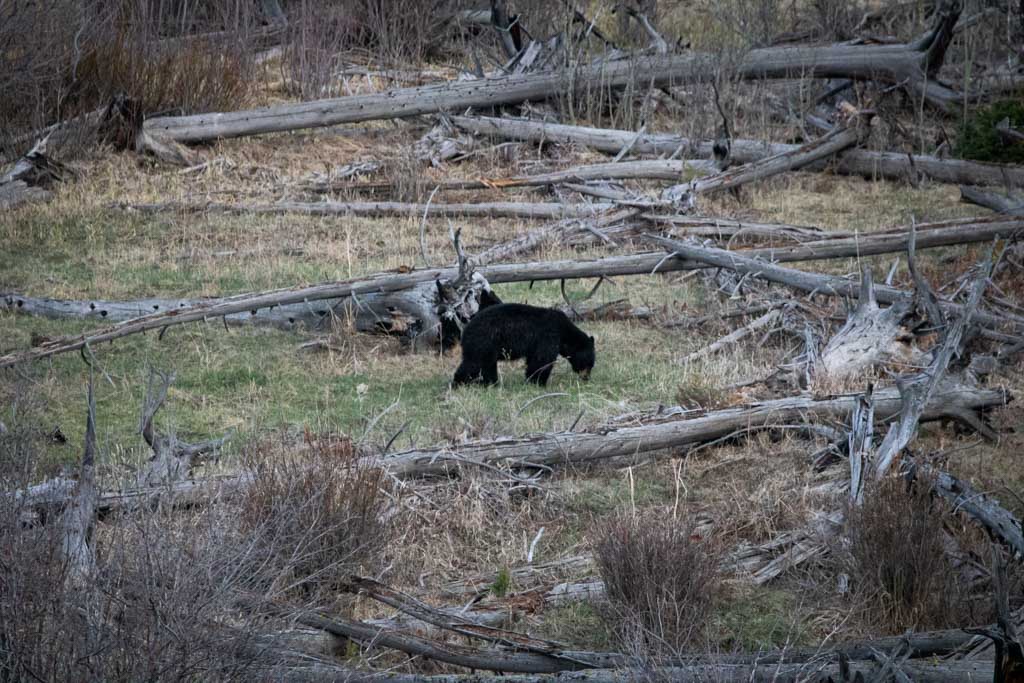
Grizzly Bear Hibernation in Yellowstone National Park
Where Do Grizzly Bears Hibernate in Yellowstone National Park?
Grizzly bears hibernate at higher elevations than black bears. A typical grizzly bear den is found in the middle or upper third of north-facing 30°-60° slopes at an altitude between 6,500 and 10,000 feet.
The reason why bears—both black and grizzly—choose north-facing slopes is that those slopes accumulate lots of snow during winter, which insulates, protects, and hides the den.
Grizzlies tend to excavate their own den. However, they may occasionally use a previously occupied den, especially one in a cave or other naturally protected area. They prefer sandy soil and usually dig a den underneath a large tree amid dense vegetation.
Those self-excavated dens usually collapse in the spring, mainly due to snowmelt and water runoff, and cannot be used again.
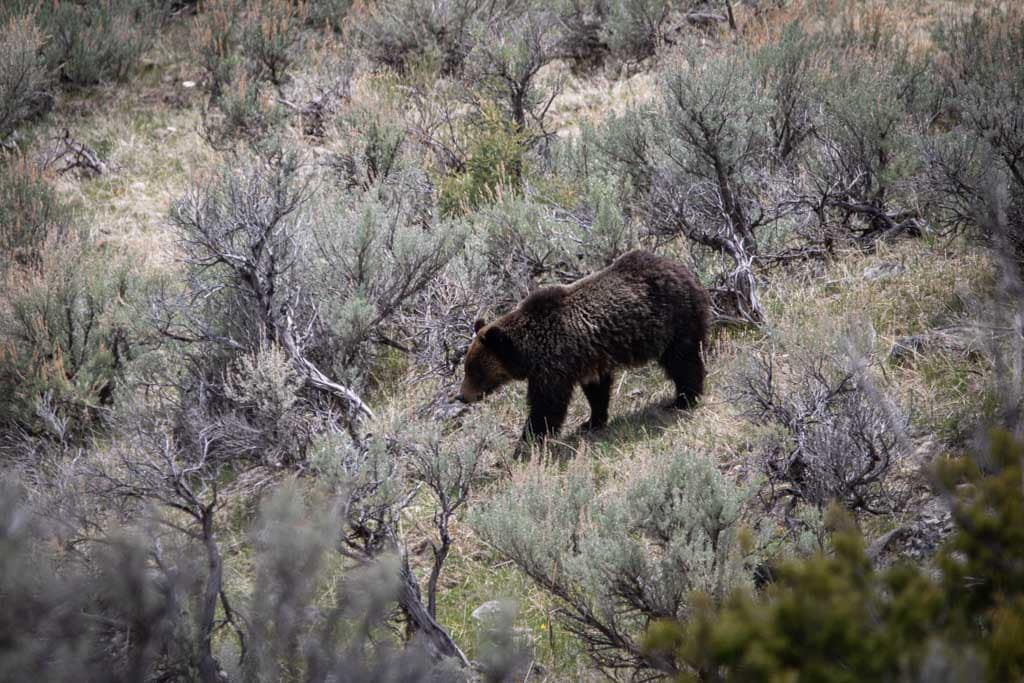
When Do Grizzly Bears Start Hibernation in Yellowstone National Park?
Similar to black bears, grizzly bears begin hibernating in November. The exact time depends on multiple different factors, including temperature, food availability, and snowfall.
Grizzlies might start their hibernation a bit earlier than black bears, mainly because their dens are at a higher altitude—meaning lower temperatures and increased chance of snowfall.
The first grizzly bears to enter their dens are pregnant females, followed by females with yearlings or two-year-old cubs. Solitary females start their hibernation next. The last grizzlies to move into their dens for winter are adult males.
When Do Grizzly Bears Emerge From Hibernation in Yellowstone National Park?
Male grizzly bears are the first to leave their dens after hibernation in Yellowstone. This usually happens in early-March, but may vary by a couple of weeks in either direction.
The next grizzlies to emerge are solitary females and females with yearlings or two-year-old cubs, usually sometime in April. Lastly, females with newborn cubs emerge.
By early-May, most grizzly bears will be awake and out of their dens.
- Male grizzly bears: early-March
- Solitary female grizzly bears: late-March to mid-April
- Females with yearlings or two-year-old cubs: April
- Females with newborn cubs: late-April to early-May
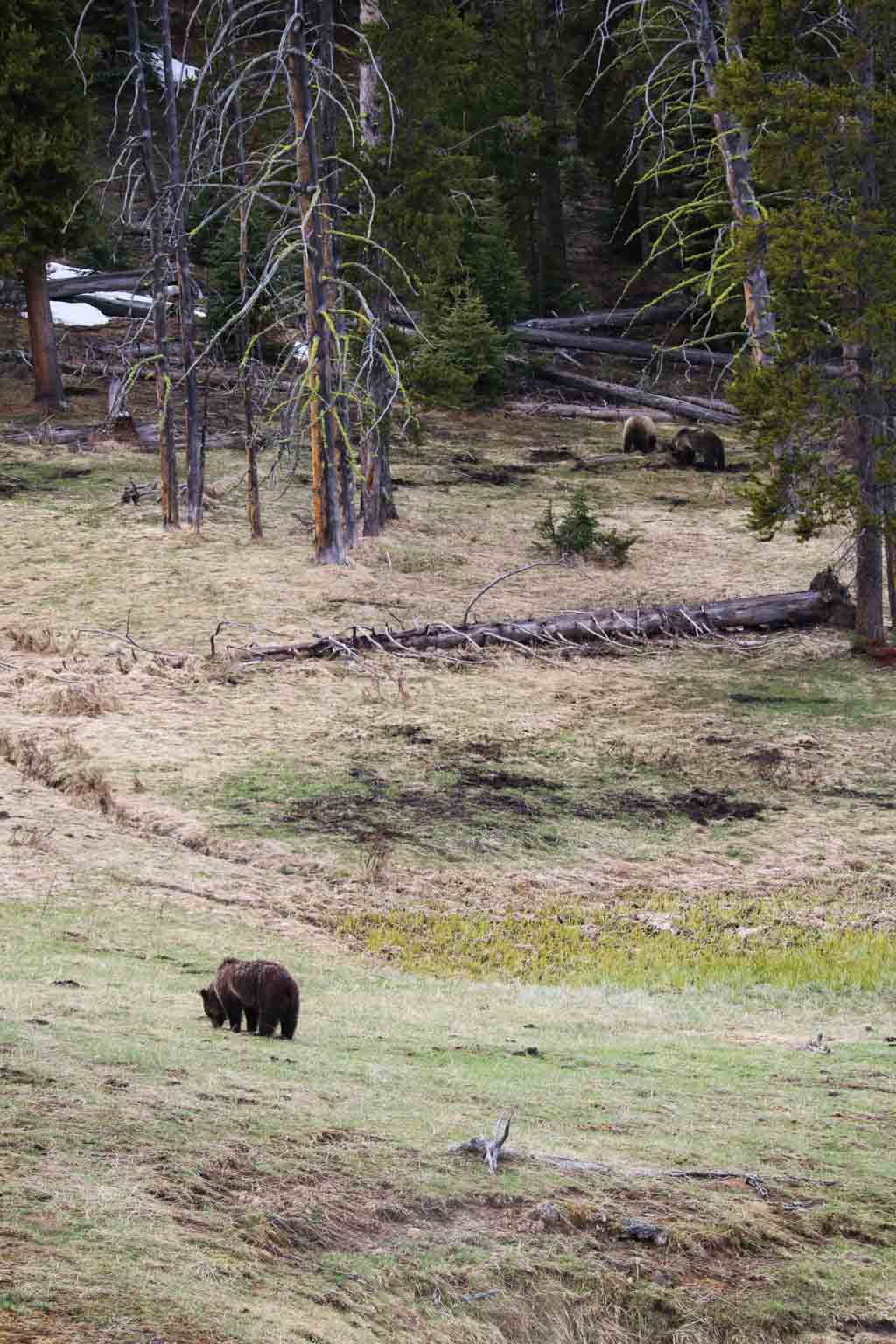
How Long Do Grizzly Bears Hibernate in Yellowstone National Park?
Yellowstone grizzlies hibernate for approximately 4-6 months. The actual duration of hibernation can vary and depends on various factors, including weather conditions and the bear’s gender.
What Do Grizzly Bears Eat After Hibernation?
Having lost 15-30% of their body weight, Yellowstone’s grizzly bears are ravenous after those many months of hibernation and not eating anything.
Their primary source of food after hibernation are winter-killed ungulates like bison, elk, and deer.
Additionally, grizzly bears consume large quantities of grasses and sedges, roots, dandelions, horsetails, and insects like ants—you can often see them digging and searching for food in spring.
They also prey on rodents, bison and elk calves, and trout.
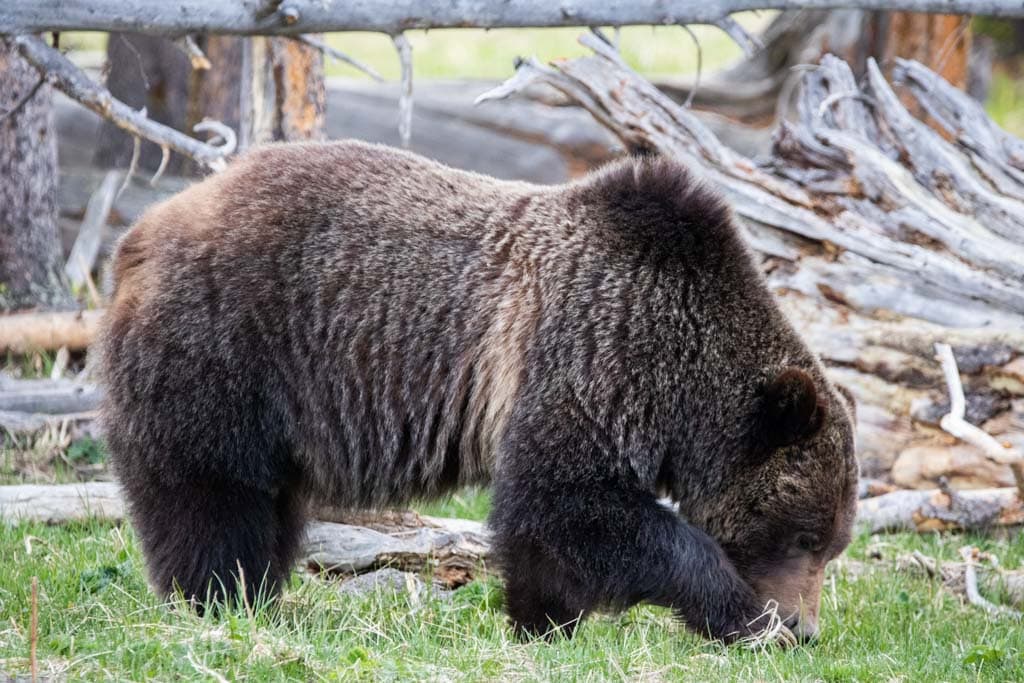
How to Distinguish Between Black Bears and Grizzly Bears
It’s good—and in case of an encounter, potentially life-saving—to know the difference between black bears and grizzly bears.
Usually however, with some keen observation and the information you’ll find below, it’s relatively easy to figure out whether you’re looking at a black bear or a grizzly.
Black Bear Characteristics
The American black bear (Ursus americanus) lives in most of the forested regions of the United States and Canada.
This includes many mountainous areas, from the Northeast and the Appalachians to the Great Lakes region, the Rocky Mountains, and much of the West, including Alaska.
It is the smallest of the three bear species found in North America—the polar bear is number three and by far the largest. Extremely adaptable, black bears present all over the country, in at least 40 states.
You can recognize a black bear by its straight face profile, small claws, large protruding ears, and lack of shoulder hump. Although they’re called “black,” black bears can also be dark brown, brown, blue-ish black, and cinnamon.
Adult black bears weight between 135-200 pounds (females) and 210-315 pounds (males) and stand about 3 feet at the shoulder.
“Little is known about the black bear population in Yellowstone,” the National Park Service says. What is clear, though, is that black bears are very common throughout Yellowstone National Park.
They’re often seen in areas like Blacktail Deer Plateau, Tower-Roosevelt, Lamar Valley, and Hayden Valley. Black bear population estimates in Yellowstone range from 500-600 individuals.
Grizzly Bear Characteristics
A subspecies of the brown bear, grizzly bears (Ursus arctos horribilis) are, on average, much larger than black bears.
Their most distinctive body features are their large claws and, especially, their clearly visible shoulder hump. Both these characteristics help grizzlies dig for food.
Additionally, grizzly bears have short, rounded ears and a so-called “dished” face profile—a nose that somewhat sticks out from their face.
The fur color of Yellowstone grizzlies varies from blond to gray to almost black. “In the Greater Yellowstone Ecosystem, many grizzly bears have a light-brown girth band,” according to the National Park Service.
“However,” the agency adds, “the coloration of black and grizzly bears is so variable that it is not a reliable means of distinguishing the two species.”
Adult grizzly bears weigh between 200-400 pounds (females) and 200-700 pounds (males) and stand 3.5 feet at the shoulder.
“Grizzly bears are generally 1.5 to 2 times larger than black bears of the same sex and age class within the same geographic region,” the National Park Service specifies.
The grizzly bear population in the Greater Yellowstone Ecosystem is estimated to be around 1,000 individuals. Approximately 150-200 of those have a home range that’s either partially or entirely within Yellowstone National Park.
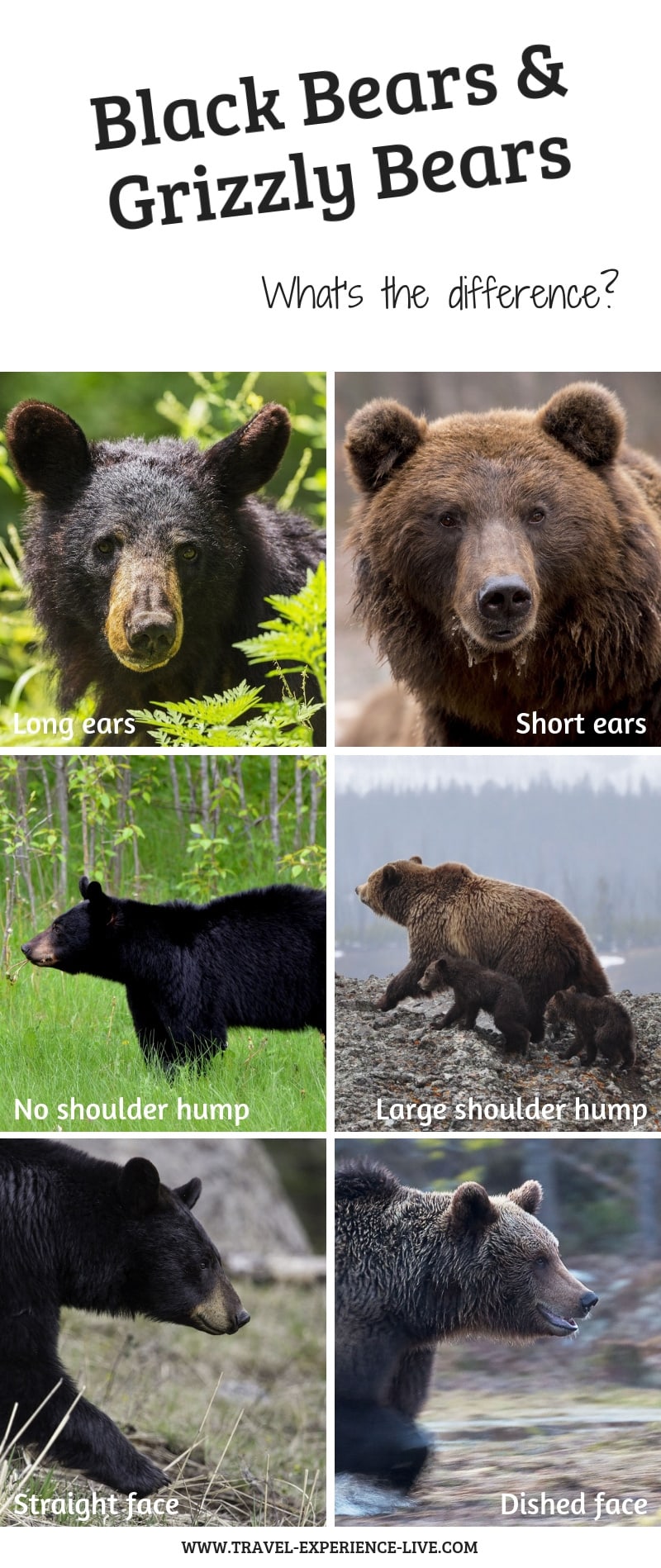
Bear Safety in Yellowstone
While this is an article about black and grizzly bear hibernation in Yellowstone National Park, I’d be remiss if I didn’t include a section about bear safety.
Particularly in the weeks before and after hibernation, bears can be especially dangerous. These are the times they’re most hungry.
In fall, they go through a phase called “hyperphagia,” when they’re almost-insatiably hungry and their body weight increases by about 3 pounds every day.
In spring, on the other hand, they’ve just spent months without eating and are, understandably, ravenous. They’ll eat anything they can get their paws on.
So, with that in mind, it’s important to know what to do when encountering a bear in Yellowstone (or elsewhere, for that matter). I strongly recommend reading the two bear safety guides below before visiting bear country.
Additionally, and no less importantly, you should always carry bear spray when out and about in Yellowstone National Park. That includes even the busiest boardwalks and crowded parking lots. Learn how to use bear spray correctly here.
Recommended Books About Yellowstone National Park
- Yellowstone and Grand Teton National Parks (Full-Color Travel Guide) – Fodor’s Compass Guides
- Hiking Yellowstone National Park: A Guide To More Than 100 Great Hikes – Falcon Guides
- Empire of Shadows: The Epic Story of Yellowstone – George Black
- Deep Into Yellowstone: A Year’s Immersion in Grandeur & Controversy – Rick Lamplugh
- Yellowstone Ranger: Stories from a Life in Yellowstone – Jerry Mernin
- Decade of the Wolf: Returning the Wild to Yellowstone – Douglas Smith & Gary Ferguson
- The Reign of Wolf 21: The Saga of Yellowstone’s Legendary Druid Pack – Rick McIntyre
- Wild Rescues: A Paramedic’s Extreme Adventures in Yosemite, Yellowstone and Grand Teton – Kevin Grange
- Bring Jade Home: The True Story of a Dog Lost in Yellowstone and the People Who Searched for Her – Michelle Caffrey
- Taken by Bear in Yellowstone: More Than a Century of Harrowing Encounters between Grizzlies and Humans – Kathleen Snow
- Death in Yellowstone: Accidents and Foolhardiness in the First National Park – Lee H. Whittlesey

